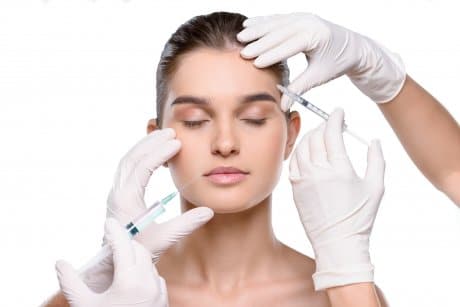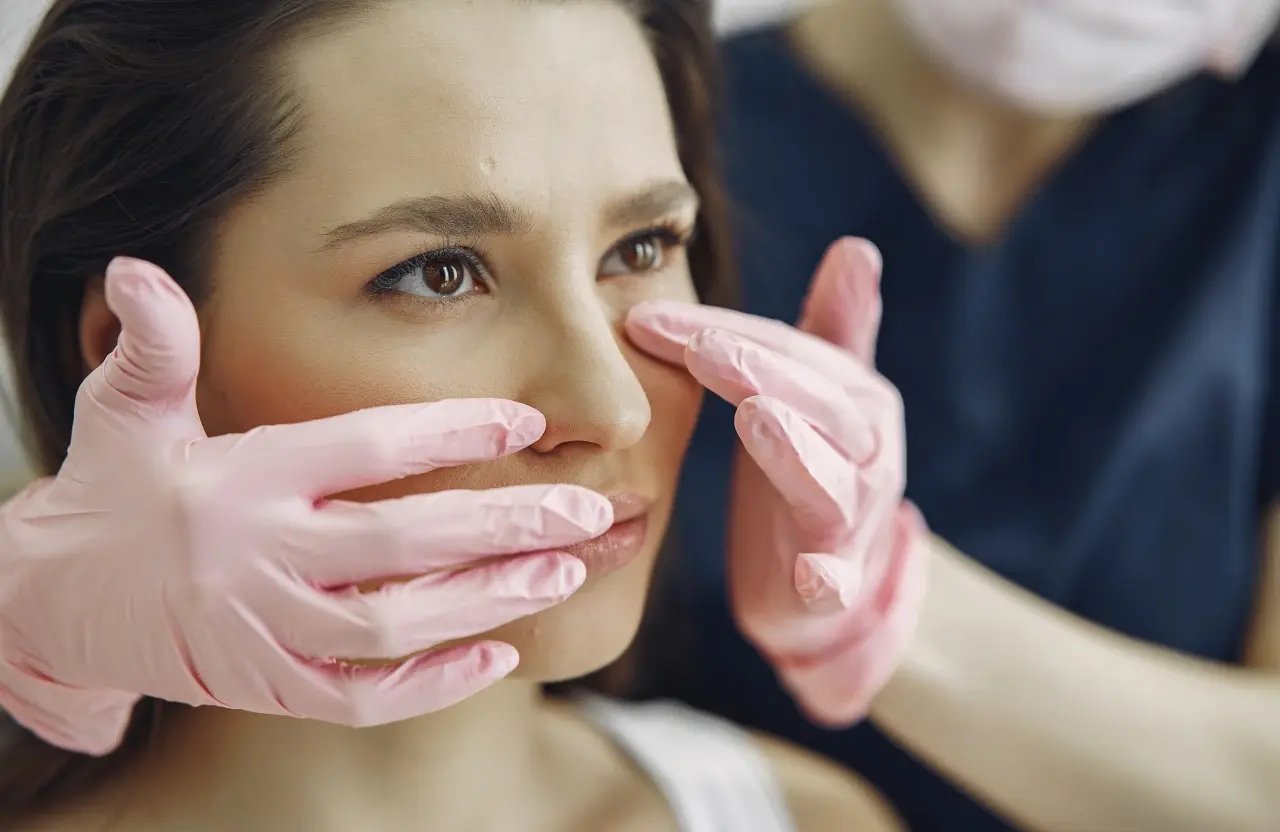Botox and fillers are two of cosmetic medicine’s most popular non-surgical treatments for reducing signs of aging.
As a medical professional, it is crucial to understand the similarities and differences between these treatments to ensure that patients receive the best possible care.
This article will compare dermal fillers vs. Botox, exploring their uses, treatment process, and potential side effects.
What is Botox?
Sometimes patients ask: is Botox a dermal filler? The answer is: no. Botox (short for Botulinum toxin) is a neurotoxin protein produced by the bacterium Clostridium botulinum.
It is a medication commonly used for medical and cosmetic purposes, such as treating muscle spasticity, reducing wrinkles, and preventing excessive sweating.
Botox blocks nerve signals that cause muscle contractions, leading to temporary muscle paralysis. When injected into a specific muscle, it prevents that muscle from contracting; and thus reduces or prevents wrinkles, fine lines, and other signs of aging.
Botox effects typically last several months, after which the muscle function gradually returns to normal. However, the exact duration of the results may vary from patient to patient.
What Are Fillers?
Dermal fillers are gel-like products based on collagen, hyaluronic acid, or synthetic bases for filling soft tissue spaces and correcting facial skin defects. Naturally-based products retain the effect for up to a year, while synthetic-based products retain the effect for up to 3 years.
Fillers are most commonly used to combat wrinkles and scars. However, they are also excellent for correcting the face, lips, and chin shape. Fillers are usually injected with a fine needle (cannula) with minimal discomfort.
The depth of injection depends on the wrinkle depth in the treatment area. Health professionals use thicker filler injections with thicker needles for deeper wrinkles, so anesthesia is required. Sessions usually last about half an hour.
Indications: Botox vs. Dermal Fillers
Both treatments are popular and well-known in cosmetology. They may be used interchangeably, but they have different indications. Here we will discuss them.
Indications for Botox:
Botox is commonly used to treat wrinkles and fine lines caused by repeated facial expressions: it is especially effective at reducing forehead wrinkles, frown lines, and crow’s feet. In addition to its cosmetic benefits, Botox treats various medical conditions, including excessive sweating, muscle spasms, and migraines.
Indications for Fillers:
Fillers are most commonly used to restore volume to the face, particularly in areas where the skin has lost volume due to aging.
They are used to fill deep wrinkles, such as those around the mouth (nasolabial folds), and to plump up hollow areas of the face, such as the cheeks and under the eyes. In addition to their cosmetic benefits, fillers can also correct certain medical conditions, such as scars and asymmetry of the face.
Botox and fillers are both popular cosmetic treatments used to enhance facial aesthetics. However, they are used to address different concerns. Botox is primarily used to treat wrinkles caused by repeated facial expressions, while fillers are best suited for restoring volume.
Despite their various indications, there is some overlap in their use. When used together, they can achieve optimal results.
Procedure for Botox and Fillers
Step-by-step Botox injections treatment process:
1. Patient evaluation and consultation. Before the procedure, the patient must undergo a thorough evaluation and consultation to determine if they are a suitable candidate for Botox injections. The practitioner should discuss the patient’s medical history, potential contraindications, and desired effects
2. Preparation The practitioner cleanses the skin and applies topical anesthetic or ice to minimize discomfort if needed. They map out the injection sites using anatomical landmarks, ensuring the patient understands the areas they will treat.
3. Injection technique. The practitioner designated for injecting Botox into the pre-determined regions, using a sterile, fine-gauge needle. Use the correct technique to avoid blood vessels while ensuring they place the Botox within the targeted muscle belly. Multiple injections are typically required to treat each area. They tailor the injection depth, and amount of Botox used to the patient’s needs.
4. Post-injection care The patient should not manipulate the treated areas and lie flat for several hours to prevent diffusing the Botox to adjacent areas. Patients should also avoid exercise and alcohol for 24 hours, preventing the risk of bruising.
A step-by-step Dermal Fillers treatment process:
• Patient evaluation and consultation. Before the procedure, the patient should undergo a thorough evaluation and consultation to determine if they are a suitable candidate for dermal fillers.
The practitioner should discuss the patient’s medical history, potential contraindications, and desired outcomes.
• Preparation. After the consultation, the practitioner preps the patient for the procedure. They cleanse the skin and apply topical anesthetic or ice to minimize discomfort if needed. The practitioner then maps out the injection sites using anatomical landmarks.
The practitioner then injects the dermal filler into the predetermined areas using a sterile, fine-gauge needle or cannula. Use of proper techniques as a means to avoid blood vessels and ensure the filler is places within the targeted skin layers of the skin and/or subcutaneous tissue. Multiple injections are typically mandatory to properly treat each area, and a tailored injection depth and amount of filler adjusted to the patient’s needs.
• Post-injection care. After the injections, the practitioner will advise the patient not to manipulate the treated areas and to lie flat for several hours to prevent diffusing the filler to adjacent areas. Patients should also avoid exercise and alcohol for 24 hours, preventing the risk of bruising.
• Monitoring and adjustments. The practitioner should closely monitor the patient after the procedure to ensure the desired outcome is achieved and that there are no adverse effects. Sometimes, the practitioner may need to adjust the injection sites or the amount of filler used to optimize the result.
Botox vs. Fillers: Comparison and Side Effects
The most common side effects include injection site pain, bruising, and swelling. More severe complications can occur if the toxin spreads beyond the injection site, such as drooping eyelids or difficulty swallowing. Practitioners need to be highly skilled in this procedure. They must carefully evaluate and select patients to minimize risks and side effects.
The most common side effects include injection site pain, swelling, and bruising. More severe complications can occur if they inject the filler into a blood vessel, causing tissue damage or blindness. Practitioners must use proper techniques and avoid high-risk areas to minimize risks and side effects.
Both procedures involve careful evaluation, mapping, and injection techniques to achieve optimal results while minimizing the risks and side effects of dermal fillers and Botox treatments.
Practitioners must be highly trained and skilled while continuously evaluating and adjusting their techniques. They must adequately screen and inform patients of potential risks and benefits before treatment.
Results of Botox and Fillers
Regarding the results of Botox and fillers, there are a few key factors to consider. First, it’s essential to understand that both treatments take time to show their full effect. With Botox, patients typically see results within a few days, but it can take up to two weeks to see the full effect.
Fillers, however, usually provide immediate results that continue to improve over a few days as swelling or bruising subsides.
In terms of longevity, Botox typically lasts around 3 to 4 months before the effects begin to wear off, and the patient needs to return for another treatment. Fillers can last anywhere from 6 to 18 months, depending on the specific product used and the area of the face treated.
Comparing dermal fillers and Botox injection results depends on the patient’s needs and goals. Botox is best for smoothing out wrinkles and fine lines caused by repetitive facial movements, such as crow’s feet or frown lines.
Fillers, however, are better suited for adding volume to areas of the face that have lost fullness over time, such as the cheeks or lips. Both treatments can effectively achieve a more youthful, rejuvenated appearance. Still, it’s essential to tailor the treatment plan to the specific patient to achieve the best possible results.
Patient Selection for Botox and Fillers
When selecting Botox and dermal fillers, essential factors include patient goals, medical history, and skin condition.
Botox is ideal for addressing wrinkles caused by repetitive facial movements, but not recommended for pregnant or breastfeeding patients or those with certain medical conditions.
Dermal fillers are best suited for restoring lost volume and improving skin elasticity. Health professionals do not recommend them for patients with autoimmune or bleeding disorders; or pregnant or breastfeeding patients.
Careful selection based on individual needs and goals achieves optimal results and patient satisfaction.
In conclusion, Botox and fillers are popular cosmetic treatments used to address signs of aging and improve facial appearance. However, there are essential differences between the two treatments.
One significant difference is their mechanism of action. Botox temporarily relaxes the muscles, which causes wrinkles and fine lines. Fillers add volume to the skin and plump up areas of the face that have lost fullness.
Another essential difference between Botox and fillers is the duration of the results. Botox typically lasts 3 to 4 months before the effects wear off, and the patient will need another treatment. Fillers can last anywhere from 6 to 18 months, depending on the specific product used and the area of the face treated.
Despite these differences, both procedures achieve a more youthful, rejuvenated appearance.
The final decision to choose fillers or Botox should depend on the individual patient’s needs and goals, as well as their medical history and skin condition. A consultation with a qualified provider can help determine the best course of treatment to achieve the desired results.
FAQ
Is it better to get dermal filler or botox?
The choice between Botox and fillers depends on the patient’s goals. Botox treats wrinkles caused by repetitive facial movements, while fillers restore volume to areas that have lost fullness. A consultation with a qualified provider can help determine the best treatment plan for achieving the desired results.
Is filler or botox more expensive?
Fillers are more expensive than Botox because they require more products. However, Botox and filler costs vary depending on the product used, the provider’s experience, and the patient’s needs. We recommend the patient discuss the price with a qualified provider to determine the most appropriate treatment plan.
Which is safer: filler or botox?
When a qualified medical professional with the proper training and experience administers Botox and fillers, one can consider them safe. However, some potential risks and side effects associated with both treatments exist. Each treatment’s safety depends on the patient’s medical history, needs, and goals.
*Disclaimer: The contents of this article are not to be constructed as medical advice but for informational purposes only. MedicaDepot staff does not review any of these articles for medical validity. Opinions and views expressed in this article are not endorsed by MedicaDepot. Please always consult your doctor for professional medical advice.








